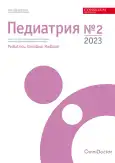The role of ultrasound diagnostics in the management of patients with juvenile psoriatic arthritis
- Authors: Chebysheva S.N.1, Geppe N.A.1, Polyanskaya A.V.1, Galstian L.A.1, Alexakova N.V.1, Zhelannikova A.V.1, Hajiyeva K.H.1, Shirinskaya O.G.1, Pilch A.D.1, Shevchenko T.Y.1, Nikolaeva M.N.1, Afonina E.Y.1, Korsunskaya I.M.2,3, Sakania L.R.2,3, Farber I.M.1
-
Affiliations:
- Sechenov First Moscow State Medical University (Sechenov University)
- Center for Theoretical Problems of Physico-Chemical Pharmacology
- Moscow Scientific and Practical Center of Dermatovenereology and Cosmetology
- Issue: No 2 (2023)
- Pages: 205-209
- Section: Articles
- URL: https://pediatria.orscience.ru/2658-6630/article/view/624175
- DOI: https://doi.org/10.26442/26586630.2023.2.202320
- ID: 624175
Cite item
Full Text
Abstract
Psoriatic arthritis (PsA) is a chronic inflammatory disease of the peripheral joints, entheses, and spine joints, affecting 10–25% of patients with psoriasis. Early diagnosis of the disease is challenging due to the possible delayed skin and joint symptoms and signs. Before the advent of ultrasound examination, the diagnosis of joint diseases was limited only to the radiological method. The ultrasound diagnosis of joint diseases in children is not established and needs a more comprehensive study.
Materials and methods. The study included 50 PsA patients aged 3 to 17 years. We performed an ultrasound examination of 178 various joints. Knee joints were involved in 46 children, hip joints in 24, ankle joints in 34, and interphalangeal joints in 10. The mean age at onset was 7.8 years (range 1.5 to 14 years). The mean duration of the disease was 4.7 years.
Results. Homogeneous joint effusion was the most common finding in patients with juvenile PsA (JPsA) – 83%. The effusion heterogeneity (17%) was due to hyperechoic inclusions (fibrin) in anechoic content. Diffuse synovium thickening was found in 91% of the joints. In 12.3% of joints, cartilage thinning was observed (in patients with a disease duration of 5 years or more), with fuzzy contours in some cases and normal echostructure in others.
Conclusion. Periarticular structures, most often ligaments and tendons, are also involved in JPsA. The inflammation progresses steadily, with the rate depending on disease activity. Joint ultrasound is a reliable and highly informative method of JPsA diagnosing. It can identify a wide range of joint abnormalities; moreover, the severity of ultrasound abnormalities correlates with the disease severity, enabling using this method for monitoring disease-modifying therapy and as a screening tool for detecting the early signs of arthritis in patients with psoriasis. Joint ultrasound helps to detect early abnormalities.
Full Text
About the authors
Svetlana N. Chebysheva
Sechenov First Moscow State Medical University (Sechenov University)
Author for correspondence.
Email: svetamma@gmail.com
ORCID iD: 0000-0001-5669-4214
Cand. Sci. (Med.), Assoc. Prof.
Russian Federation, MoscowNatalia A. Geppe
Sechenov First Moscow State Medical University (Sechenov University)
Email: geppe@mail.ru
ORCID iD: 0000-0003-0547-3686
Sci. (Med.), Prof.
Russian Federation, MoscowAngelina V. Polyanskaya
Sechenov First Moscow State Medical University (Sechenov University)
Email: svetamma@gmail.com
ORCID iD: 0000-0002-4125-0335
Cand. Sci. (Med.)
Russian Federation, MoscowLelia A. Galstian
Sechenov First Moscow State Medical University (Sechenov University)
Email: svetamma@gmail.com
ORCID iD: 0000-0002-5616-3998
Cand. Sci. (Med.)
Russian Federation, MoscowNatalia V. Alexakova
Sechenov First Moscow State Medical University (Sechenov University)
Email: svetamma@gmail.com
Department Head
Russian Federation, MoscowAnna V. Zhelannikova
Sechenov First Moscow State Medical University (Sechenov University)
Email: svetamma@gmail.com
Ultrasound Doctor
Russian Federation, MoscowKhaybat H. Hajiyeva
Sechenov First Moscow State Medical University (Sechenov University)
Email: svetamma@gmail.com
Ultrasound Doctor
Russian Federation, MoscowOlga G. Shirinskaya
Sechenov First Moscow State Medical University (Sechenov University)
Email: svetamma@gmail.com
Cand. Sci. (Med.)
Russian Federation, MoscowAnna D. Pilch
Sechenov First Moscow State Medical University (Sechenov University)
Email: svetamma@gmail.com
Cand. Sci. (Med.)
Russian Federation, MoscowTatiana Ya. Shevchenko
Sechenov First Moscow State Medical University (Sechenov University)
Email: svetamma@gmail.com
Ultrasound Doctor
Russian Federation, MoscowMaria N. Nikolaeva
Sechenov First Moscow State Medical University (Sechenov University)
Email: svetamma@gmail.com
Department Head
Russian Federation, MoscowElena Yu. Afonina
Sechenov First Moscow State Medical University (Sechenov University)
Email: svetamma@gmail.com
Department Head
Russian Federation, MoscowIrina M. Korsunskaya
Center for Theoretical Problems of Physico-Chemical Pharmacology; Moscow Scientific and Practical Center of Dermatovenereology and Cosmetology
Email: svetamma@gmail.com
ORCID iD: 0000-0002-6583-0318
Sci. (Med.), Prof.
Russian Federation, Moscow; MoscowLuisa R. Sakania
Center for Theoretical Problems of Physico-Chemical Pharmacology; Moscow Scientific and Practical Center of Dermatovenereology and Cosmetology
Email: imfarber@gmail.com
Dermatovenerologist
Russian Federation, Moscow; MoscowIrina M. Farber
Sechenov First Moscow State Medical University (Sechenov University)
Email: imfarber@gmail.com
ORCID iD: 0000-0001-6919-6732
Cand. Sci. (Med.)
Russian Federation, MoscowReferences
- Жолобова Е.С., Мелешкина А.В., Чебышева С.Н., Алексанян К.В. Особенности клинической картины псориатического артрита у детей. Педиатрия. Журнал имени Г.Н. Сперанского. 2019;98(3):67-73 [Zholobova ES, Meleshkina AV, Chebysheva SN, Aleksanyan KV. Peculiarities of psoriatic arthritis clinical picture in children. Pediatria n.a. G.N. Speransky. 2019;98(3):67-73 (in Russian)]. doi: 10.24110/0031-403X-2019-98-3-67-73
- Чебышева С.Н., Геппе Н.А., Мелешкина А.В., и др. Место ультразвуковой диагностики при псориатическом артрите у детей. Лечащий врач. 2015;8:54-6 [Chebysheva SN, Geppe NA, Meleshkina AV, et al. Mesto ul'trazvukovoi diagnostiki pri psoriaticheskom artrite u detei. Lechashchii vrach. 2015;8:54-6 (in Russian)].
- Волков К.Ю., Свинцицкая И.С., Тыренко В.В., и др. Ультразвуковая диагностика в ревматологии: возможности и перспективы. РМЖ. 2020;7:9-13 [Volkov KYu, Svinitskaya IS, Tyrenko VV, et al. Ultrasonic diagnostic in rheumatology: capabilities and prospects. RMJ. 2020;7:9-13 (in Russian)].
- Российские клинические рекомендации. Ревматология. Под ред. Е.Л. Насонова. М.: ГЭОТАР-Медиа, 2017 [Rossiiskie klinicheskie rekomendatsii. Revmatologiia. Pod red. EL Nasonova. Moscow: GEOTAR-Media; 2017 (in Russian)].
Supplementary files













